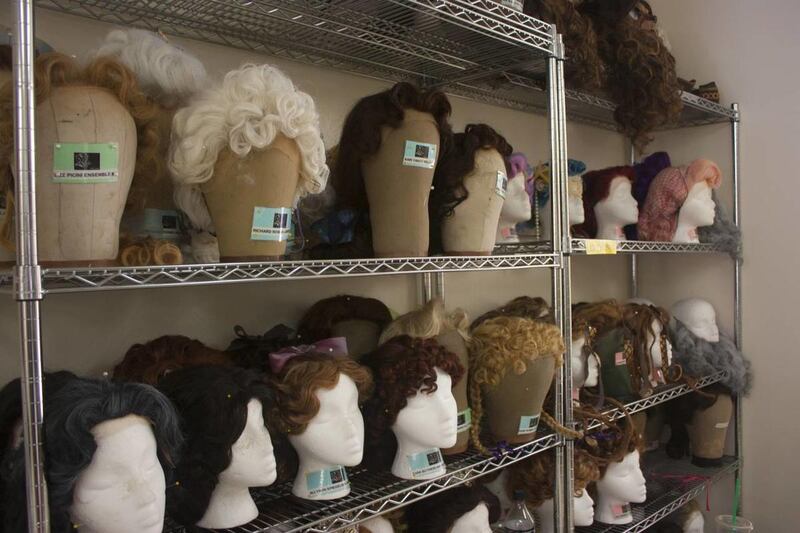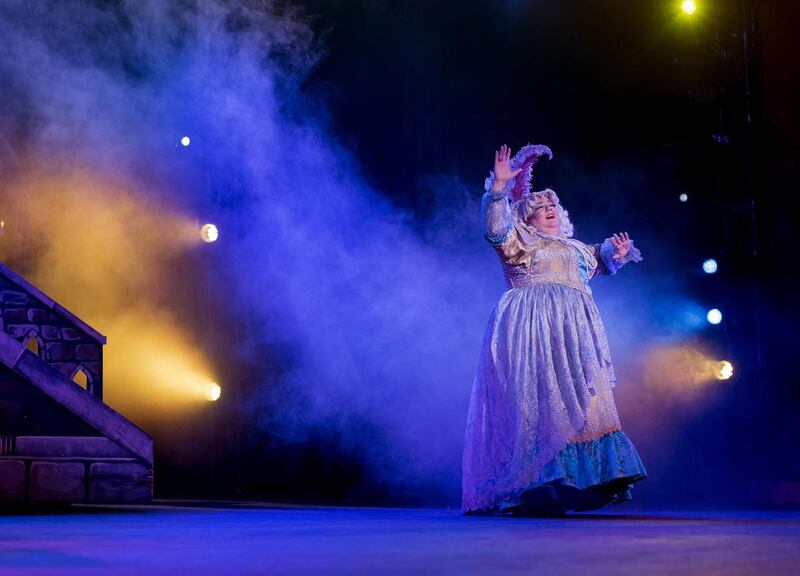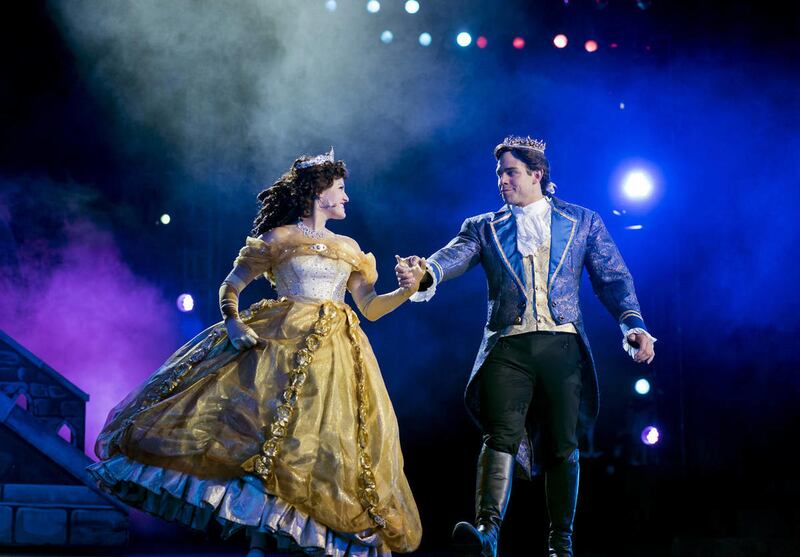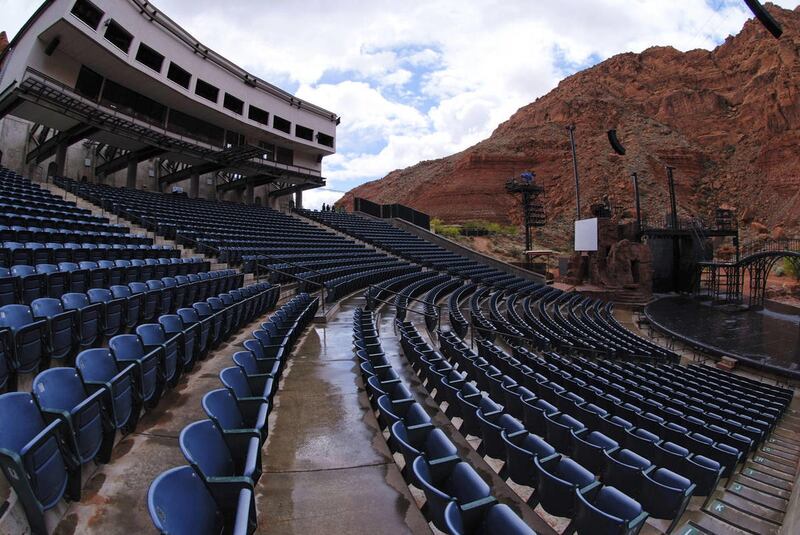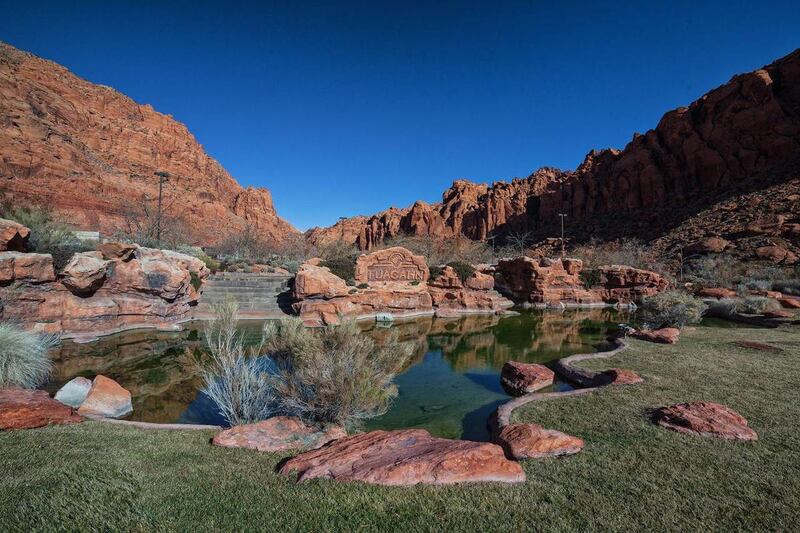IVINS, Washington County — With approximately 260 wigs used between Tuacahn Amphitheatre’s current shows, wig designer Matthew Oliver and wig assistant Izchel Hernandez have their work cut out for them maintaining the pieces.
“We have a lot of wigs,” Hernandez said. “A lot a lot of wigs.”
It’s a 9-5 job most days during the summer as the majority of the wigs have to be washed, recurled and redressed every other night, a task that requires almost 60 cans of hair spray each month.
But as Oliver puts it, it’s a crucial part of “bringing theater to life.”
“You’re not just putting something on the head because it’s pretty,” Oliver said. “It’s that final finish and really seals in who the character is. Rapunzel is nothing without her hair; Jasmine is nothing without her ponytail. It’s a nice finisher, and it’s essential.”
It’s just one of the many things staff members at Tuacahn Center for the Arts in Ivins have done over the course of the organization’s 20-year history to create memories for their patrons — a process that administrators hope in turn “inspires creativity and greatness in the human spirit,” according to Tuacahn’s mission statement.
“We want to create memorable experiences and we want to create meaningful experiences, both artistically and educationally, and I think we’re accomplishing that in a big way,” Kevin Smith, Tuacahn’s CEO, said in an interview with the Deseret News.
‘Waiting to inspire’
Although Tuacahn Center for the Arts is celebrating its 20th anniversary this season, the amphitheater’s history can be traced back even further to the early 20th century and a man by the name of Orval Hafen.
Tuacahn’s website states that Hafen and his wife, Ruth, purchased land and built a home at the mouth of Padre Canyon and dreamed that one day others would “share this beauty and drink of the inspiration.”
“I was awestruck,” Hafen wrote of the towering red rock canyon that would one day become Tuacahn’s home. “There before me lay a scene of indescribable beauty: wild, primitive, unspoiled, largely unknown, waiting to be enjoyed, waiting to inspire folks.”
It was thanks to playwright and St. George resident Doug Stewart’s ambition that Hafen’s vision became a reality decades later. According to a 2010 Deseret News article, Stewart spent the early ’90s daydreaming about “finding the perfect amphitheater where he could stage an epic outdoor performance.”
He found the same spot Hafen had settled on, knew it was the place he’d been looking for and began raising funds for an amphitheater. He invited local businessman Hyrum Smith out to see the property, and Smith caught the vision and agreed to fund the project.
The 1,900-plus-seat amphitheater and 42,000-square-foot art center were completed and dedicated in the spring of 1995, and the organization debuted an original musical titled “Utah!” that summer. The show, which told the story of Jacob Hamblin, one of the early Mormon settlers in St. George, was the amphitheater’s exclusive offering until 1999, when “the Tuacahn Board felt that it needed to shift its strategy and pursue a new direction,” according to the website.
“We’re proud of what we accomplished with ‘Utah!’ but after several years of one show, it was clear that people wanted to see something new,” Kevin Smith said in the organization’s published history.
That summer began a tradition of bringing Broadway favorites to Ivins as Tuacahn performed “Joseph and the Amazing Technicolor Dreamcoat” and “Seven Brides for Seven Brothers.”
With each year, the amphitheater’s name spread further through the world of theater, attracting more Broadway-experienced actors and stage crew and greater opportunities.
Artistic director Scott Anderson sees Tuacahn’s relationship with the theater arm of Disney as being among the highlights of the organization. Although Anderson notes there is no official agreement between Tuacahn and Disney, a “mutually beneficial relationship” has been formed between the two companies.
“I think that the West is a family friendly place, and I think that Disney’s theatrical offerings are right in line with that,” Anderson said.
Tuacahn has celebrated many milestones with Disney productions, including performing “The Little Mermaid” and “Mary Poppins” shortly after their Broadway runs, as well as staging the regional premiere of “Aladdin.”
In addition to performing “Beauty and the Beast” for the second time in the amphitheater’s history this summer, Tuacahn is also premiering Disney’s “When You Wish,” which Anderson and his crew have worked closely with Disney to create. It’s a compilation of popular Disney songs and stories made into one theatrical experience that Anderson says is more than just a musical revue.
“We call it a musical spectacular,” he said. “These are big production numbers of some of Disney’s greatest hits.”
Tuacahn also hosts various concerts in the amphitheater in the fall and spring as well as its live nativity and Festival of Lights in the winter. And with construction on an additional 19,000-square-foot arts center slated to begin in October, the canyon Hafen hoped would inspire others is increasingly being filled year-round with musical and theatrical experiences.
“I had somebody actually ask me one time, ‘How did you create that beautiful backdrop?’ and I said, ‘Well, we didn’t. Nature created that, and it took a long time, but we’re blessed to be able to take advantage of that,’” Smith said. “We want the experience to match the majesty of this canyon.”
‘Educate and motivate’
While Anderson acknowledges that one of the main functions of Tuacahn Amphitheatre is to entertain patrons, he believes the effects of the art run even deeper.
“It can teach, it can inspire, it can educate and motivate and emotionally move people,” Anderson said. “I think the idea is to make people feel better about their lives (so) they’ll want to go out and do something more with their lives, and that’s what we’re hoping to do.”
One of the biggest ways Tuacahn seeks to “educate and motivate” the community beyond its summer performances is through Tuacahn High School for the Performing Arts, a charter school founded by officials at Tuacahn Center for the Arts that opened its doors for the first time in 1999.
“Our mission has always been at Tuacahn to not only do professional quality family entertainment but to also do quality education … and now here came this idea (Tuacahn High School), and we were then able to in a bigger way fulfill the mission of doing not only arts education but education in general,” Smith said.
The high school offers six areas of emphasis for students — actor training, dance, music, musical theater, theater tech and visual art — in addition to “college-preparatory academic curriculum,” according to the school’s website. What began as a small group of 86 students has now blossomed into a student body of around 375 ninth- through 12th-graders.
“Not every kid fits in at a really large high school, and so this became a choice,” Smith said. “They can come here, and they become a big fish in a little pond, get the personalized instruction they need to be successful, and they get to focus on the arts if that’s their interest.”
Creating ‘magical moments’
Tuacahn’s technical director, Wes Hamblin, is a sort of jack of all trades. Considering all that he’s responsible for in Tuacahn’s productions, he has to be.
“If it’s onstage and it’s not an actor, it’s mine,” he said.
With up to three major productions running at the same time, each with its own technical and staging needs, it’s not unusual for Hamblin and his crew to be planning how to flood the stage; create a rain curtain; project images on the canyon wall; drive antique cars onto the stage; lead horses, goats, chickens and other animals into the scene; use pyrotechnics; and lift actors and actresses into the air on zip lines all in the course of one summer — but it’s effects such as those that Smith says bring a “reality” to the shows.
“Some people call it spectacle, magical moments, whatever. We’re not going to apologize for trying to create those here at Tuacahn as much as possible,” Smith said.
Many of the special effects Tuacahn is now known for are available as a result of the theater’s outdoor setting — a trait of which Anderson says the staff takes full advantage.
“I think the unique environment allows you to do things with the shows that sometimes will touch people in a different way than they might sitting in an indoor theater,” he said.
For Hamblin, managing the tech crew, scenic artists, props and effects can add up to a lot of pressure, but he enjoys it.
“When I wake up in the morning I have no idea what the day brings, so there’s that kind of excitement with it, but there’s a fair amount of stress that comes with it because you know that 2,000 people are going to be out there watching it and you need to try to be able to execute it the same way every night for 50 performances,” he said.
Whenever he finds himself nitpicking a performance for every little thing that went wrong, he makes sure to go up on the plaza after the show and see the crowd’s excitement as they take photos and interact with the cast.
“You sometimes need those moments — because we are so focused on what went wrong and what do we need to fix — those moments up there (on the plaza) when you realize those people didn’t see the thing I saw, they saw the overall story, the overall picture, and it was meaningful and rewarding to them,” Hamblin said. “When it’s magical for the audience, sometimes even when you know the trick, it’s magical for us too.”
If you go ...
What: Disney's "When You Wish"
Where: Tuacahn Amphitheatre, 1100 Tuacahn Drive, Ivins
When: through Oct. 16
How much: $22.50-$69.50
Phone: 435-652-3300
Web: tuacahn.org
Also ...
What: Disney's "Beauty and the Beast"
When: through Oct. 17
How much: $28.50-$79.50
Also ...
What: "Sister Act"
When: July 31-Oct. 15
How much: $28.50-$79.50
Email: wbutters@deseretnews.com, Twitter: WhitneyButters

